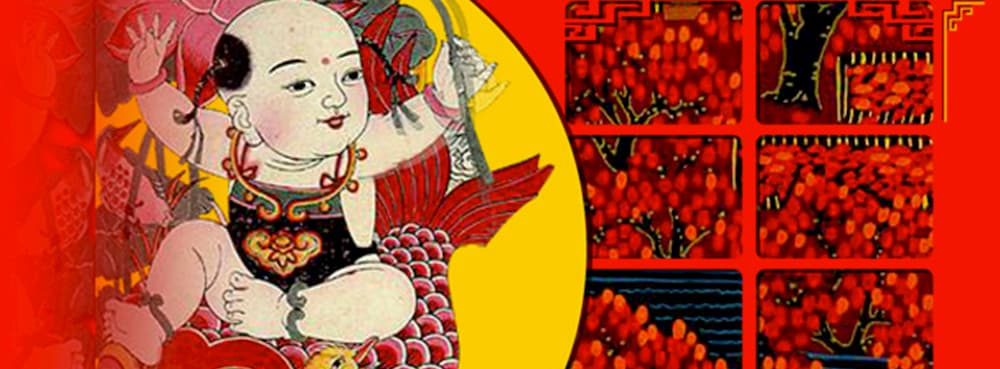
New Year Pictures
Splendid
Chi Culture
Topic
New Year Pictures
The Chinese people value celebrations of the lunar New Year, or Spring Festival, during which almost every family pastes “spring couplets” on both sides of their front doors. Some families also post “spring pictures” on interior doors or in rooms. These pictures are collectively known as New Year pictures.
The pictures pasted indoors are decorated with auspicious motifs. One popular example depicts a lotus and fish design known as “year of lotus yields fish,” a rebus for “having surplus year after year,” reflecting the Chinese people’s wishes for a prosperous future.
The Chinese like to put images of “door gods” on their front doors during the Spring Festival. Before the Tang dynasty (618–907), door gods were Shentu and Yulei, two mythical brothers who excelled at capturing demons. They would arrest demons who harm people, tie them up with rope, and feed them to tigers. In order to expel evil spirits, people began to put depictions of Shentu and Yulei on their doors. There is another tradition in which the names of the gods are given as Qin Shubao (d. 638) and Yuchi Jingde (585–658), two Tang dynasty generals who stood guard outside the bedroom of Emperor Taizong (r. 626–649) during a serious illness so he could sleep at night. This worked so well that their pictures were posted permanently outside the imperial bedchamber. From that time on, Qin Shubao and Yuchi Jingde became the new door gods during the Spring Festival, even among commoners.
Although no accurate record exists of the origins of New Year pictures in China, the “Sang daji” (Grand record of mourning) section of the Li ji (Record of rites), which was compiled over 2,000 years ago, notes that “an emperor who came to his minister’s house to offer condolences would first bow to the door gods.” This record shows that the Chinese have utilized door gods for at least 2,000 years.
During the Spring Festival, Chinese people paste door gods on their front doors to ensure security and hang auspicious pictures inside to express good wishes for a prosperous life. Over centuries of development, these New Year pictures have matured into a unique genre of folk art.
China’s New Year pictures are deeply rooted in traditional art forms. After the Tang dynasty, the production of New Year pictures was enriched by progressive societal changes and the development of a vibrant folk culture. Traditional Chinese folk art and crafts peaked during the Ming (1368–1644) and Qing (1644–1911) periods.
New Year pictures consist primarily of mass-produced decorative prints. In addition to door gods, the subjects of these woodblock prints include festivals, auspicious objects, as well as a variety of scenes from folk tales, novels, and operas. They provide a visual encyclopedia of folk life and customs. Most creators of New Year pictures do not receive an education in art. Their craft is passed down from master to apprentice through successive generations.
China has a large market for the decorative prints. In the mid-Qing dynasty, as the New Year pictures developed into a unique genre of art, there emerged four major production centers: Yangliuqing in Tianjin, Taohuawu in Suzhou, Weifang in Shandong, and Mianzhu in Sichuan. These pictures are locally favored, and they embody their respective regional characteristics in terms of coloring, composition, shape, and function.
The Yangliuqing picture of Tianjin has existed for over 400 years, and “each and every household was skilled at painting” in its heyday. Influenced by imperial aesthetics of the neighboring Beijing, the Tianjin pictures, with exquisite composition and rich coloring, are sold throughout Northern China. Their prints of beautiful women and babies are especially favored. The Taohuawu picture of Suzhou, with its delicate and elegant workmanship, has also enjoyed a history of over 400 years. Brightly colored, and featuring traditional operas, classical fiction, and local customs, Taohuawu pictures are widely popular in the Yangtze Delta region.
Besides Yangliuqing, Taohuawu, Weifang, and Mianzhu, there are other areas, where New Year pictures are produced and are locally influential. They include Yangjiabu in Shandong, Wuqiang in Hebei, Zhuxianzhen in Henan, Zhangzhou in Fujian, Liangping in Chongqing, and Fengxiang in Shaanxi.
In the past, Chinese New Year pictures were produced with woodblock printing. Some pictures required a few woodblocks to overprint multi-colors. With the introduction of modern printing technology from the West, the production of today’s New Year pictures are even brighter in coloring and finer in composition.



